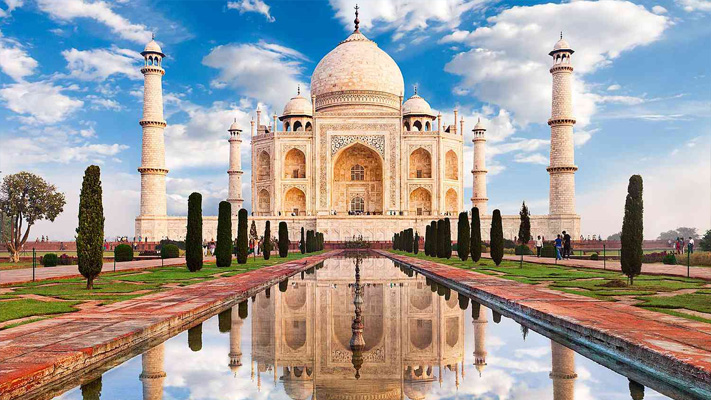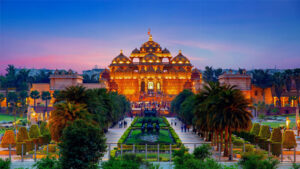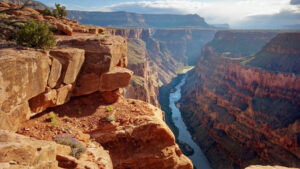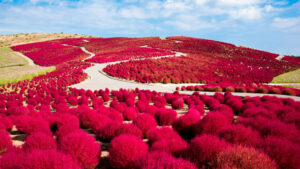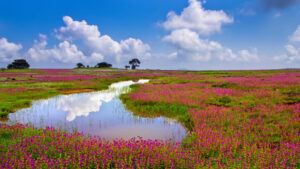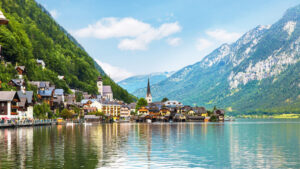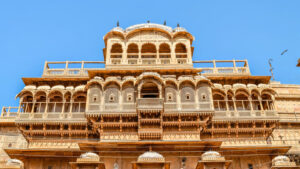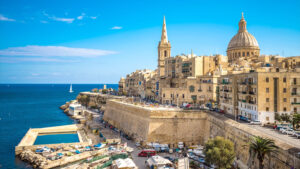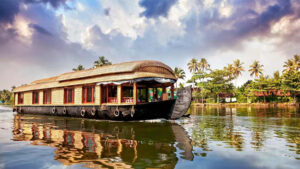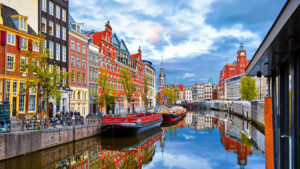TAJ MAHAL, AGRA – THE EPITOME OF LOVE AND BEAUTY

The Taj Mahal is a world-famous mausoleum located in the city of Agra in northern India. It was built by Mughal Emperor Shah Jahan as a tribute to his beloved wife Mumtaz Mahal, who died during childbirth in 1631. Construction of the Taj Mahal began in 1632 and took over 20 years to complete, with the help of thousands of skilled artisans, workers, and architects.

The monument is made of white marble and is renowned for its intricate carvings, inlaid precious stones, and beautiful symmetry. The central dome is flanked by four smaller domes and is surrounded by four minarets. The Taj Mahal is situated on a raised platform in a beautiful garden, which includes reflecting pools, fountains, and pavilions.
The Taj Mahal is widely considered a masterpiece of Mughal architecture and a symbol of love. It has been designated as a UNESCO World Heritage Site and is one of the most visited tourist attractions in India, attracting millions of visitors each year.
Interesting Facts
Here are some interesting facts about the Taj Mahal:
- The Taj Mahal was built as a mausoleum for Emperor Shah Jahan’s wife, Mumtaz Mahal, who died during childbirth.
- It took more than 20 years and 20,000 workers to complete the construction of the Taj Mahal.
- The white marble used to build the Taj Mahal was transported from over 200 miles away, by a fleet of 1,000 elephants.
- The Taj Mahal changes color depending on the time of day and the angle of the sun, from a pinkish hue in the morning to a golden glow at sunset.

- The calligraphy on the Taj Mahal is done in a style known as Nastaliq, and is so perfectly proportioned that it looks the same size from any distance.
- The Taj Mahal is surrounded by four minarets, each tilted slightly away from the main building. This was done so that in case of an earthquake, they would fall away from the main building and not damage it.
- The Taj Mahal’s dome is made of white marble and is surrounded by 80 smaller domes, which are said to represent the 80 different versions of the Quran.
- The Taj Mahal is said to have cost around 32 million rupees, which would be equivalent to around $1 billion today.
- The Taj Mahal attracts millions of visitors each year and is considered one of the world’s most beautiful buildings.

- The Taj Mahal was designated as a UNESCO World Heritage Site in 1983 and is often considered one of the Seven Wonders of the World.
Things to Do
Here are some things to do when visiting the Taj Mahal:
- Admire the Taj Mahal at different times of the day: The monument looks different in the early morning, afternoon, and evening, so try to visit at different times to appreciate the changing colors and moods.
- Take a guided tour: A guided tour can provide insight into the history, architecture, and symbolism of the Taj Mahal, enhancing your understanding and appreciation of the monument.
- Visit the Taj Mahal Museum: The museum, located inside the Taj Mahal complex, houses artifacts related to the construction and history of the monument, including drawings, plans, and photographs.
- Explore the gardens: The gardens surrounding the Taj Mahal are beautifully landscaped and provide a serene and peaceful environment to relax and enjoy the scenery.

- Take a photo from the iconic Diana Bench: The bench located in front of the Taj Mahal is known as the “Diana Bench,” as it was famously photographed by the late Princess Diana during her visit to India.
- See the Taj Mahal from the Mehtab Bagh: The Mehtab Bagh is a garden complex located across the Yamuna River from the Taj Mahal, providing a different perspective of the monument and a peaceful escape from the crowds.
- Attend the Taj Mahotsav: The Taj Mahotsav is an annual festival held in February that celebrates the art, culture, and cuisine of India, providing a vibrant and colorful atmosphere.
- Take a sunrise or sunset tour: Sunrise and sunset tours offer a unique opportunity to witness the Taj Mahal in a stunning display of colors and light, making for a truly unforgettable experience.
Must-See Nearby Places
If you are visiting the Taj Mahal, here are some nearby places that you must see:
- Agra Fort: Located just 2.5 km away from the Taj Mahal, Agra Fort is a UNESCO World Heritage Site and a must-see attraction. The fort was built in the 16th century and served as the main residence of the Mughal Emperors.

- Fatehpur Sikri: Located around 40 km from Agra, Fatehpur Sikri is a historic city built by Mughal Emperor Akbar in the late 16th century. The city was abandoned after just a few years due to water shortages, but it remains an impressive sight with its well-preserved buildings and stunning architecture.
- Itmad-ud-Daulah’s Tomb: Also known as the Baby Taj, this beautiful mausoleum is located just 6 km from the Taj Mahal. Built in the 17th century, it was commissioned by Nur Jahan, the wife of Emperor Jahangir, in memory of her father.
- Jama Masjid: Located in the heart of Agra, the Jama Masjid is a stunning mosque built in the mid-17th century. The mosque features beautiful architecture, intricate carvings, and stunning views of the city.
- Mehtab Bagh: Located across the Yamuna River from the Taj Mahal, Mehtab Bagh is a beautiful garden complex that offers stunning views of the monument. The garden is an ideal spot for a picnic or a relaxing stroll.
- Keetham Lake: Located around 20 km from the Taj Mahal, Keetham Lake is a peaceful and serene spot that offers boating, birdwatching, and hiking opportunities.
- Chini ka Rauza: Located just 6 km from the Taj Mahal, Chini ka Rauza is a beautiful tomb built in the 17th century. The tomb is famous for its stunning blue glazed tiles and intricate carvings.
Best Time to Visit

The best time to visit the Taj Mahal is during the winter months between October and March, when the weather is cooler and more pleasant, making it ideal for sightseeing and outdoor activities. It is important to note that the Taj Mahal is closed on Fridays, so plan your visit accordingly. Additionally, the Taj Mahal can get crowded, especially during peak season, so it’s best to arrive early in the morning or later in the afternoon to avoid the crowds and long lines.
If you plan to visit during the summer months, which run from April to June, be prepared for high temperatures that can reach up to 40°C (104°F) and high humidity levels.


